Convair XFY-1 Pogo, A What-if – Lindberg 1/48
In another universe not so far away...
Marine Lieutenant Wally Warren was not a happy camper in the spring of 1968. His plan to avoid being sent to Southeast Asia by becoming a flight instructor had come to a screeching halt when he had flown a T-28 (with the base commander's bikini clad daughter in the back seat) into the only really large tree within a hundred miles of the Beeville NAS. Not only had that slight mishap earned him a trip overseas, it also resulted in a new call sign, George of the Jungle, bestowed by squadron mates convulsed with laughter while singing "Watch out for that treeeeeeeeee!"
In addition to being assigned to Vietnam, the base commander also tasked Warren with finding ways to improve air support for the Marines on the ground. There was no problem with the mission itself, but rather with the time it took to get air assets on site after being called. Aircraft had to stage from ground bases or aircraft carriers far from the fighting, and often, by the time they arrived, it was too late. Building forward airfields could be costly and would require scarce manpower to defend, while the available helicopters were too slow, vulnerable and could not carry enough ordinance that went bang to be effective.
The answer to Lt. Warren's quest came unwittingly during his pre-deployment leave to San Diego, where he befriended a buxom young lady who happened to work for Convair. During a tour of the factory, while the lady went to powder her nose, Warren wandered off, stumbling onto an old hangar on the factory's back lot. A peek inside revealed what appeared to be a dusty zinc chromate colored Christmas tree standing in a corner. The Christmas tree turned out to be an odd looking airplane standing on its tail, which immediately piqued Warren's interest. Somewhat miffed that the only answer he could get to his questions about the weird flying machine was "Well, that's that goofy Pogo thing we tried to fly a few years back," Warren headed to a local library to find a copy of Jane's to figure out what the thing was. What he learned convinced him this was the answer to his problem.
Wartime tends to breed odd occurrences, and this one was no exception. Warren's excited report gathered enough interest from generals and senator's hoping to add voters to their districts to get a program started on the feasibility of using VTOL attack aircraft on the front lines. Knowing that the Navy had failed to make the Pogo work only added to the urgency.
After much research, Warren decided that many changes would be needed to make the Pogo service ready. He immediately enlisted the aid of one Sgt. J. Carreon, who when not building low riders in Pacoima was keeping various Marine airplanes flying. Sgt. Carreon's first reaction to seeing the Pogo was "What the f...!" which was repeated often enough by enough people to become the official motto of the Pogo program. A major overhaul of the airplane commenced.
The finicky Allison T-40 double turboprop engine was immediately replaced by the Pratt and Whitney T-34, which with some tweaks to the fuel control scheduling and modifications to the hot section, was able to produce 6,500 shaft horsepower. A larger air scoop under the nose had to be added, but other airframe modifications to accommodate the new engine were minimal. The unreliable Curtiss electric props were replaced by 16-foot diameter Hamilton Standard hydramatic units, and the gearbox for the counter rotating propellers was redesigned and beefed up. Sgt. Carreon, addressing the need to see behind the aircraft while landing, visited a local Radio Shack and came away with a video camera and monitor. The camera was mounted in a bullet shaped fairing on the upper fin, while the monitor was bolted to the glareshield in front of the pilot. This is now acknowledged as the world's first back-up camera. A modified three axis autopilot, yaw damper and hydraulically boosted controls were installed to further aid the landing process. By unanimous vote from the pilots, an ejection seat was added.
By January 1969, the first modified XFY-1B Pogo was ready for it's first flight Convair test pilot William (Willie) Makeit flew the aircraft tethered in a hangar for the first time on January 21st, with engineer Bedford (Beddy) Dont handling the winch attached to the tether that kept the Pogo from falling over during the tests. Two weeks later, Willie Makeit was making full vertical takeoffs and landings, with the transition from vertical to horizontal flight occurring a week later. Lt. Warren flew the airplane soon after that. It was reported after Warren's first landing that a radio transmission screaming "WHAT THE F...!" was received. By March, a dozen Marine pilots had flown the Pogo. One additional modification resulted from these flights; the addition of flaps to slow the aircraft down for the approach to the landing pitchup. Convair received a contract for 30 airframes, and the project was on.
Marine squadron VMF(V)-13, with Lt. Warren (promoted to captain) in command, was activated on April 1st, 1969, becoming the first VTOL fixed wing fighter squadron in the world. The Pogo was redesignated the AV-1 Arrow, but everyone still called it the Pogo. By August, there were enough airframes in service to send the squadron to China Lake for training and weapons testing. A few more modifications were made, and by November, the squadron was ready for deployment.
The squadron shipped to Vietnam aboard the escort carrier USS Danger Bay, arriving the week before Christmas. Upon landing the first Pogo at Da Nang, the ATC controller exclaimed "WHAT THE F...!" The squadron codes became by default WT, to which a squadron wag added a small "F" after the letters were painted on each aircraft. Several problems became immediately apparent. Nobody had noticed that the castering 'landing gear" did not come equipped with brakes until one Pogo rolled off a slight incline and fell into a slit trench. Sgt Carreon and his crews immediately rigged a cable operated brake system operated by a lever on the stick. The airplane was so tall, that it wouldn't fit in a standard sandbagged revetment, and two more were destroyed by mortar fire. The sandstorm kicked up by the props, and the fact the aircraft had to fly through it's own propwash on descent still made the aircraft a handful on landing, but the camera, a new radio altimeter and the autopilot eased that to some extent.
The squadron deployed the day after Christmas, and the first combat missions were flown in January 1970. More problems arose. The dust issue was resolved by building rolling platforms, which could be towed by an APC or deuce and a half trucks, for the aircraft to land on. The aircraft proved to be most vulnerable while taking off and landing, which was never quite solved, even after they were staged several miles behind active combat areas. Most of the combat losses occurred during those phases of flight. Despite these problems, the airplane proved to be surprisingly effective, vindicating Capt. Warren's program. A normal weapons load was 4 Mk 82 500 lb bombs or napalm tanks combined with 2.75 inch rockets and a pair of 20mm cannon in the wingtip pods. Several missions were flown with Bullpup missiles as well. The airplane was fast and maneuverable, proving difficult to hit while in flight.
However, the very novelty of the airplane proved to be its undoing. Convair was never quite able to provide enough spare parts or complete airframes, forcing Sgt Carreon and his crews to become quite creative in order to keep airplanes flying. It was a losing battle however, and by August 1970, there were only seven flyable airplanes left, the others having been lost in combat, accidents or cannibalized for parts. The Marines acknowledged, that while the program was a success, it could not be sustained, and the squadron was pulled from combat in September.
The Danger Bay transported what was left of the squadron back to San Diego, and while enroute, Sgt. Carreon's mechanics were able to make 10 Pogos serviceable, so when the ship arrived in port,, the squadron was able to fly off, upholding one of the Corp's oldest aviation traditions. VMF(V)-13 was deactivated in December 1970 and the remaining aircraft were scrapped. Sgt Carreon retired from the Marines in 1976. He now builds custom hot rods. The vertical fin from ship 9552 is on the wall of his garage in El Paso, Texas. Capt Warren also retired in 1979 after marrying Miss Beeville Bikini, starting a small crop dusting service in his home town of Whefakawee, Texas. Passers by to the Warren home have reported what appears to be a large gray colored Christmas tree in the corner of his barn, to which Warren invariably replies "What the f...?"
In reality, only three Pogos were ever built, and only one of those ever flew. It actually survived and is preserved at the Smithsonian, though it is not on display. The Pogo was the first successful fixed wing VTOL aircraft ever flown.
https://airandspace.si.edu/collection-objects/convair-xfy-1-pogo
This build came about after a bunch of hilarious discussions with Joe in Florida about what might have happened if this thing had gone into service. The kit is the very old Lindberg XFY-1 Pogo, which probably went into production before I was born. It's best attribute is a low parts count, and it is pretty accurate in outline. But it is a miserable kit to build. Nothing fits well, the plastic is soft, translucent and rubbery, and everything is see-through. The best part in the kit was a beautifully crystal clear canopy, which was also the only part that fit worth a damn. A completely fictitious cockpit was built from the parts box - the tub, seat and side consoles are from a Monogram Voodoo; instrument panel from a Hasegawa Corsair and the stick from a Revell Phantom. Plugs and bulkheads were fabricated from plastic sheet. The bombs and pylons are from a Lindberg weapons set, #72520JL, that I didn't even know existed. It also comes with Bullpup missiles, rocket launchers and napalm bombs. I won't vouch for its accuracy, but it just seemed appropriate for this build. The 2.75 rockets are from a Revell Apache. The chin scoop is ex Monogram Hurricane and the camera fairing is something I found in the junkbox. Fins and the undersurfaces were all painted from Krylon spray cans, while the uppers are Model Master light gull gray. Decals came from about a half dozen sheets in the stash.
Despite its age, I have to admit I had a blast building this thing. Now I have to find a way to display it, because it's too tall on its tail to fit on my shelf!
Thanks to all for putting up with my overactive imagination...
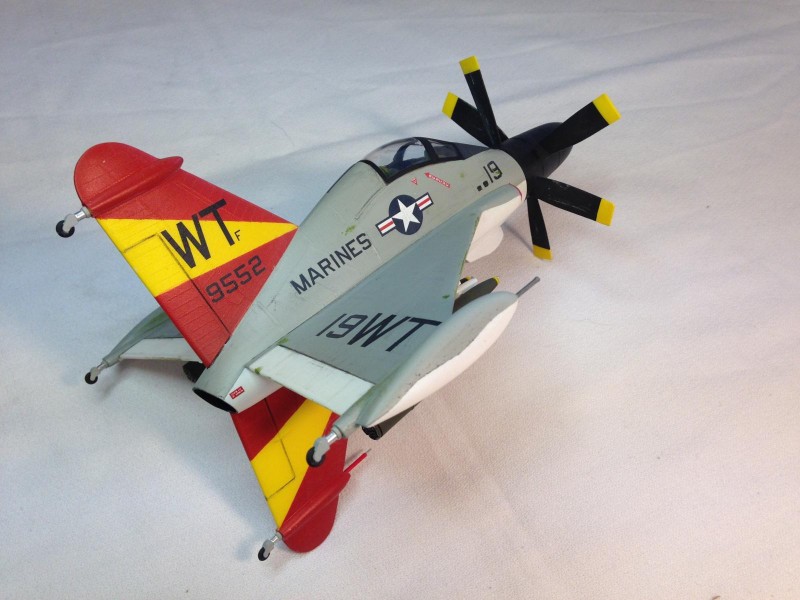
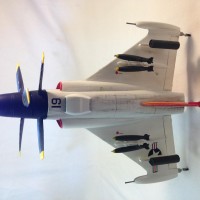

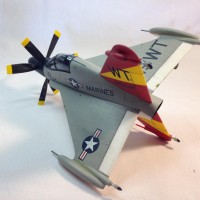
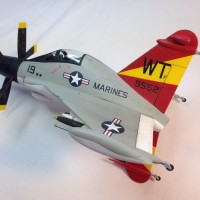
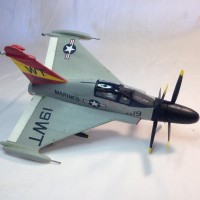
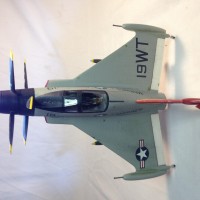
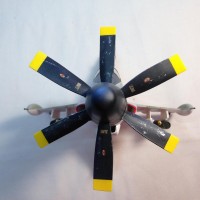
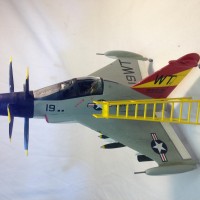

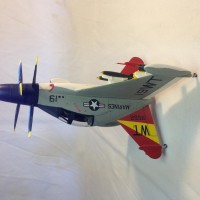
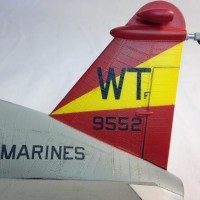
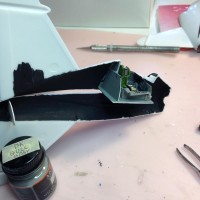
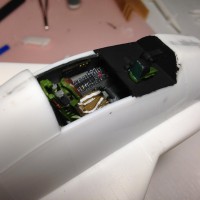

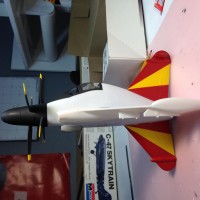
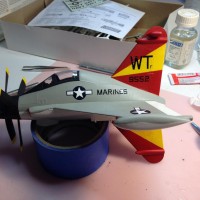
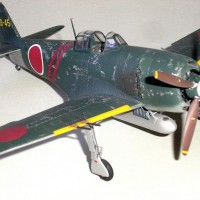
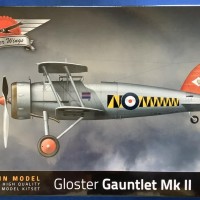
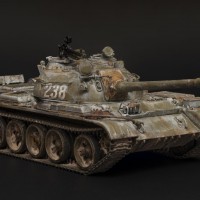
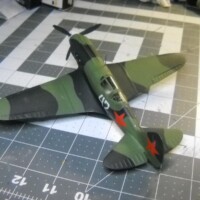
Nicely done! Looks better than the real deal.
Nice execution of a bungle of a kit! Looks very sharp.
Great article, Jaime - and a lovely build. Loved the story about the squadron codes.
Very nice build indeed. Always like the looks of this bird and these markings really set it off!
Good show!
Quite the imaginative narrative, Jaime...and a pretty nice-lookin' build, too. I like it. 🙂
Joe, from Florida, says great job, Jaime" ! Gotta love it ! Well executed !
The Marines could not have done better, themselves ! I still think an "88" in the nose would have been apropos.
nice one Jaime,to me its a strange looking aircraft,well built,thanks
Great job! did one years ago straight out of the box, often thought about a what ifer,
Fun build Jaime...looks really good.
A great story & a great build too. Like Robert, I built one many moons ago. Brings back memories. Thanks Jaime.
A spiffy paint job and a cracking yarn
You get an A for creative writing.
Also an A for creativity.
Great build, I just love the colours. Fantastic story, full of details to make it almost true. A lot of weird aircraft were built after WW2 and most didn´t make it. It must take a lot of guts to fly in such an unconventional aircraft for the first time. Maybe even more the second time around...
A George of the Jungle quote and a really cool looking Pogo-What's not to like? Great narrative and model Jaime.
Jaime, Good Stuff (the story and the model)!, I enjoy both, and it keeps the rivet counters guessing for awhile. Its always fun to see what a skilled model guy can do with some of these old kits, this is a good example of that. Ironically I was just talking to my neighbor today, about strange aircraft and this one came up.